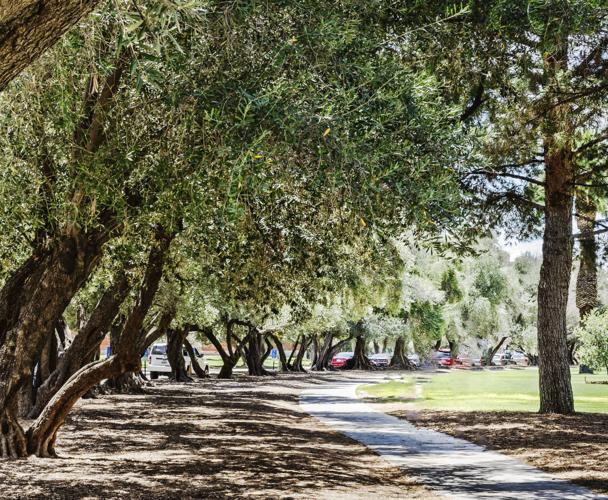The man who planted many of Tucson’s iconic olive trees was a gentlemen of many skills and interests.
Robert H. Forbes was born on May 15, 1867 on a farm near Cobden, Illinois. He attended country schools in the winter and helped with farm chores in the summer.
In 1878, his family moved to the northern part of the state, where Forbes graduated from high school in 1882. He tried his hand as a bookkeeper, teacher and retail clerk, but ultimately decided to attend the University of Illinois, where he graduated with honors in 1892. After he earned his bachelor’s degree he won the Thayer Scholarship and did post-graduate work at Harvard University.

Robert H. Forbes served in the Arizona State Legislature.
On July 2, 1894, the board of regents of the University of Arizona elected Forbes as professor of chemistry and chemist of the Agricultural Experiment Station. His arrival in Tucson was announced Sept. 8, 1894 by the Arizona Weekly Citizen newspaper, which wrote: “Mr. Robert H. Forbes, the newly elected professor of chemistry in the university and chemist of the Agricultural Experiment Station, arrived this morning from Champaign, Illinois … His valuable experience in similar work at the University of Illinois and in connection with the World’s Fair, … and at the government laboratories in Washington, have particularly fitted him for the duties of his position here.”
While the introduction in the newspaper was likely appreciated, it was a bit late — Forbes had actually been in town since the beginning of the month.
By the time he arrived in the Old Pueblo, at least one nursery, owned by David Kennedy, sold young olive trees, and at least three people — Pima County Sheriff James K. Brown, A.V. Grossetta and a Mr. Hartt — had olive trees.
The following year, on April 1, 1895, a row of olive trees from Santa Barbara was planted on the west side of the UA campus. Its unknown whether Forbes had a role in this but it’s known that later on he planted olive trees in front of the girls dormitories along what is now called North Campus Drive or James E. Rogers Way. It’s believed the trees were planted to see how well they would do in the Sonora Desert and to beautify the campus.
 |
In July 1898, after five attempts, Forbes became the first known European-American to reach the summit of Baboquivari Peak, about 50 miles southwest of Tucson. That same year he became director of the Agricultural Experiment Station.
On Jan. 14, 1902, he wed Georgie H. Scott, a school teacher who was the daughter of early Tucson pioneers Judge William F. Scott and Larcena (Pennington) Scott.
Around the turn of the century Forbes, bought land on the southeast corner of Park Avenue and Feldman Street (now Speedway) and on Oct. 15, 1904, he recorded his subdivision the Olive Hill Addition along with Olive Road. Around this time he planted the olives trees along both sides of Olive Road.
On Oct. 18, 1909, Georgie Forbes and Clara Ferrin formed the Girls Study Club at the Forbes home on Olive Road. Members included the daughters of some of the most prominent families in town such as the Goldtree, Drachman and Pusch families.
On March 17, 1915, Olive Forbes, believed to be Robert H. Forbes’ niece, left on an electric iron after pressing her dress for church in the Forbes home. Sometime after the family left for religious services, the table on which the iron sat caught fire. Professor Guild, a neighbor, put out the blaze with a fire extinguisher. There was minimal damage to the home.
In 1918, UA loaned Forbes to the Egyptian government for scientific service to the Societe Sultanienne d’Agriculture, or the Sultanic Society of Agriculture. He expected to stay for a year, but ended up spending 13 years with a a succession of engagements in Egypt, French West Africa and Haiti. In French West Africa he promoted irrigated agriculture and in Haiti he was involved in the development of Sea Island long staple cotton.
In 1931, the couple returned to Tucson and their home at 105 N. Olive Road.
From 1938 to 1952, Forbes represented Pima County in the Arizona State Legislature, focusing on agricultural and conservation legislation, especially the conservation of Arizona’s underground water supply. He also secured funds for a new building for the Arizona Pioneers Historical Society (now the Arizona Historical Society), provided it matched the funds.
In 1947, he spent his 80th birthday climbing Baboquivari Peak. In 1964, he planted an olive tree in the yard of the Arizona Pioneers’ Historical Society. He died in 1968, but many of the olive trees he planted on Olive Road and James E. Rogers Way live on.
Note: While it is generally accepted that the olive trees along Olive Road and James E. Rogers Way by Forbes came from Santa Barbara, Calif., this is disputed by Bud Simons Jr., who grew up in the area in the 1930s and wrote that the olive trees derive from stock Forbes brought from Greece in the 1890s.










